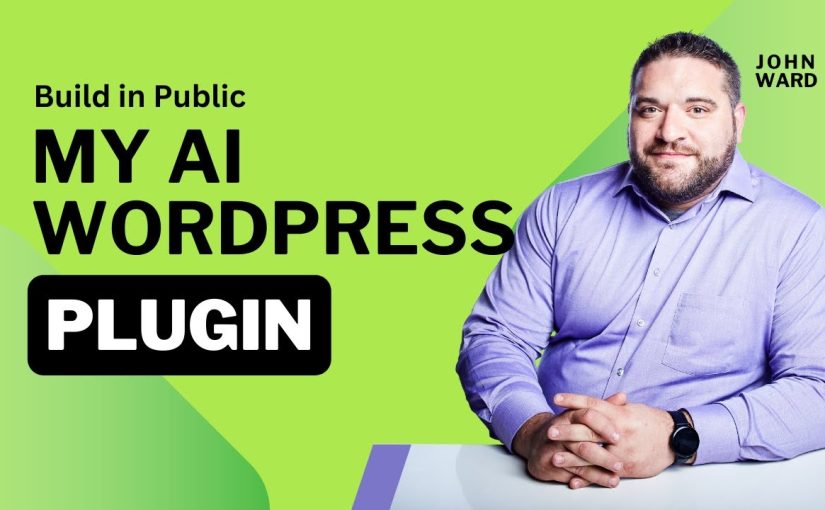Over the past few weeks, much progress has been made on various projects. The focus today includes an update on the 30-day challenge and insights into a WordPress plugin development journey.
The rank and rent project has seen significant improvements, climbing the search engine rankings and receiving steady traffic. Additionally, there is a WordPress plugin called Writer Block, a content generation tool, initially launched with a freemium model. Despite some setbacks and learning experiences, it offers valuable lessons for future software development projects.
Key Takeaways
- Update on the rank and rent campaign and its progress.
- Discussion on the development and performance of the Writer Block WordPress plugin.
- Insights gained from software development and potential future projects.
30-Day Challenge Update
Rank and Rent Update
The Rank and Rent project continues to perform well. Building around 50 local citations since early February has shown positive results. Current keyword positions are 3, 7, 9, and 12, indicating significant improvement from previous standings. All keywords are trending upward, save for one. Traffic levels remain moderate, which is typical for local SEO.
WordPress Plugin Progress
The WordPress plugin, named Writer Block, was developed as a content generation tool with a freemium model. Basic features are free, with advanced features available for purchase, relying on users’ API keys from OpenAI. Despite the instructional video, some users found generating API keys challenging. If revisited, the plugin might shift to a web-based, usage-based billing model, utilizing a proprietary key to simplify user experience.
Metrics for Writer Block were as follows:
- Total Signups: 420
- Current Active Users: 14
- Total Installs: 189
- Sales: 4
- Revenue: $68
The plugin showed limited financial returns, suggesting a possible reconsideration of the channel or approach.
Future Plans
There is potential to relaunch the project as Content Goblin, inspired by a term from industry articles. The potential exists to create a unique offering in the market, possibly integrating different functions like regular post republishing with Gen AI to conform to Google’s terms. Although immediate plans are uncertain, there is a possibility of developing this or a new tool, targeting a specific niche and incorporating innovative features. This model has been successful for other AI tools and might hold promise for future endeavors.
Rank and Rent Campaign Progress
Local SEO Performance
The campaign began in early February and has seen positive growth. Only 50 local citations were built to support this, and it is already paying off. The site now ranks in positions 3, 7, 9, and 12 for target keywords. Previously, the site was not even on the first two to three pages. It’s evident that there’s a steady upward trend in the rankings.
Position Tracking
Tracking the rankings has shown mostly positive movements. All the keywords bar one show improvement, with that one still holding a front-page position. This indicates that the strategy is effective and positioning for target keywords is on the right track.
Traffic Insights
The traffic levels are modest, which is typical for local SEO efforts. The focus has been more on rankings than sheer volume of visitors. The current phase shows encouraging growth, with traffic expected to stabilize further over time.
Future Partnership Plans
Once the rankings stabilize after a vacation, there are plans to explore partnerships with local businesses. The objective is to collaborate with these partners to further enhance site performance and possibly monetize the site through these partnerships.
Developing WordPress Plugins
Overview of the Writer Block Plugin
The Writer Block plugin was created as a content generation tool for WordPress. It allowed users to generate content by integrating with an API key from OpenAI. The plugin followed a freemium model where the basic version was free, and advanced features were available through an upgrade.
Challenges with the Freemium Model
The freemium approach presented several issues. Many users struggled with obtaining and using the required API key, despite instructional videos being available. Additionally, the conversion rate from free to paid users was quite low, making it difficult to generate significant revenue.
Issues Integrating API Keys
Integrating user-provided API keys turned out to be a complex task. Users expected the plugin to work out-of-the-box without having to generate their own keys. This misunderstanding led to dissatisfaction and reduced usability for many.
Reviewing Revenue and User Analytics
The overall user engagement was limited. Out of 420 sign-ups, only 189 installed the plugin, and just 14 remained active. In terms of revenue, only four users paid for the premium version, resulting in meager earnings of $68.
| Metric | Value |
|---|---|
| Total Sign-ups | 420 users |
| Current Active Users | 14 users |
| Installations | 189 installs |
| Total Revenue | $68 |
| Paid Users | 4 users |
Discussing Conversion Rates
Conversion from free to paid versions was notably low. This low conversion rate highlighted a potential problem with either the marketing strategy or the value proposition of the paid features. Users were not motivated enough to upgrade, which suggested a need for revisiting the offered features and their perceived value.
Using Freemius Integration
The plugin utilized Freemius to manage free and premium versions. Freemius helped in handling payments, licensing, and user management. However, Freemius did not support usage-based pricing, which limited some potential revenue models.
Listing and Updating the Plugin Directory
The Writer Block plugin was listed in the WordPress plugin directory. While listed, the plugin had not been updated for two months, which might have contributed to its decline in active usage and potential technical issues. Regular updates are crucial for maintaining compatibility and user trust.
Learning from Development Experience
Re-examining the Plugin Approach
In the past, the writer developed a WordPress plugin named “Writer Block” as a content-generating tool. The plugin was structured on a freemium model, offering a basic version for free and advanced features via a paid upgrade. This approach faced issues, primarily because users struggled with generating an API key required from OpenAI. Despite efforts to simplify the process with a tutorial video, many expected the plugin to work without additional steps.
Considering a New Content Tool
Reflecting on this, he proposed a different method for future content tools. Instead of a plugin requiring users to handle API keys, he suggested a web-based tool where the API key management is centralized. Users would be billed on a usage basis, ensuring a straightforward user experience. This kind of model is adopted by successful AI tools like Koala, which charge users with a margin over OpenAI’s fees, making it a potentially sustainable approach.
Concept of Content Goblin
Another idea in his development journey was a tool named “Content Goblin.” Inspired by a term commonly known in the SEO community, he even applied for a registered trademark for this name. While the initial version of the tool showed promise, it was put aside in favor of using other existing tools like Koala, which provided similar functionality. Content Goblin remains a potential project that could utilize unique elements from successful competitors if revisited.
Exploring Alternatives to Content Generation
Instead of focusing solely on content creation, he explored alternative uses of generative AI. Tools like “Revive.do” caught his attention, which republishes blog posts with minor edits to comply with Google’s guidelines. This methodology sparked ideas for developing new tools that use generative AI beyond content generation. His consideration of diverse applications emphasizes the potential for innovative developments in this evolving field.
SaaS Insights
Pricing Based on Usage
When looking at pricing models for SaaS, using a usage-based strategy has its challenges and benefits. This method charges users based on how much they use the service. Instead of a fixed fee, the more a user consumes, the more they pay. For example, you can use your own API key and charge a margin on top of it. This is attractive because you don’t lose money as long as there’s a margin. It offers flexibility but also comes with difficulties, such as setting up the payment system.
Comparing SaaS Solutions with Peers
Observing how other SaaS products perform gives valuable insights. For instance, tools like Koala have gained traction by sharing their progress and user base growth on social media. Looking at these examples shows a clear pattern: there’s room for growth and an existing demand. Although many similar tools exist, each successful product finds its niche through unique features or better marketing strategies. Examples can serve as an inspiration for new projects and approaches.
AI Tool Market Trends
AI tools in the SaaS market are experiencing rapid expansion. There are numerous AI content generation tools, showing an apparent market demand. Companies like Koala and Journalist AI share updates about their growing user base, indicating a healthy competitive environment. Despite the saturation, there’s potential for new entrants if they provide something unique. Exploring different uses for AI beyond content generation, such as tools that comply with search engine guidelines or offer other functionalities, could tap into unmet needs.
Final Reflections on Business Approach
The Importance of Learning Through Experience
He emphasizes the value of hands-on learning. By diving into projects, even if they don’t succeed as planned, one gains knowledge that is invaluable for future endeavors. He noted the insights gained from tackling the challenges themselves.
Tips on Taking Action and Embracing Failure
He advises that taking action is always better than hesitating. Even if a venture fails, it teaches lessons that static inaction can’t. There’s substantial potential upside to trying, with minimal downside, compared to doing nothing.

